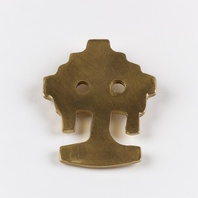
Viking Objects
Reproduction Jewellery Die Stamp
A copper alloy die for creating pressed silver or gold pendants. The original on which this is based had traces of interlace decoration. The presence of finds like this suggests that high-status jewellery production took place in the northern Danelaw.
Read More
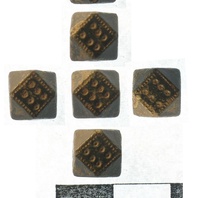
Viking Objects
Polyhedral Weight (SWYOR-3C5372)
This copper-alloy weight is of a type common within the Scandinavian diaspora. This example has fourteen sides and six dots on each of the rectangular sides. These weights were adopted by the Vikings from Middle Eastern examples and appear to have become a de facto weight standard for traders. Weights are an important form of evidence for Viking Age commerce and the use of standards across the different economic systems within which Vikings were integrated. Many of the weights discovered, particularly ones in Ireland and those of Arabic type, suggest that a standardized system of weights existed in some areas. These standard weights, alongside standard values of silver, are what allowed the bullion economy of Viking occupied areas to function. A bullion economy was a barter economy that relied on the exchange of set amounts of precious metal in various forms, such as arm-rings or coins, for tradable goods, such as food or textiles. Each merchant would have brought their own set of weights and scales to a transaction to make sure that the trade was conducted fairly.
Read More
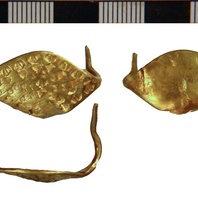
Viking Objects
Gold Finger-Ring (NLM-FC0D13)
A gold finger-ring featuring punched ring and dot decoration. The arms of this ring would have likely been twisted together which is a typically Scandinavian technique.
Read More
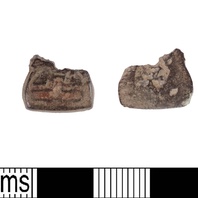
Viking Objects
Enamelled Irish Mount (LIN-9BCF25)
This item is a fragment of an Irish Early Medieval enamelled copper-alloy mount or strap-end. It is decorated with a rectangular perimeter of reserve metal which forms a ‘T’ shape. The recessed areas around and within it appear to contain degraded enamel. It is possible that it made its way to England prior to Viking incursions but it is equally likely, especially considering the Viking presence at Torksey, that the Vikings brought this mount with them as plunder after raiding various areas in Ireland.
Read More
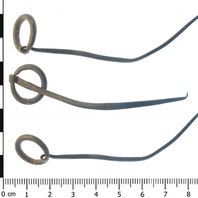
Viking Objects
Ring-Headed Pin (SWYOR-E57351)
The ringed pin was a form of dress fastener which developed as a result of contact between artisans in the Celtic West and sub-Roman Britain. The type became very popular in Ireland, being ultimately adopted by the Hiberno-Norse during the Viking period. In form it comprised a pin with a ring inserted through a looped, perforated or pierced head.
Read More
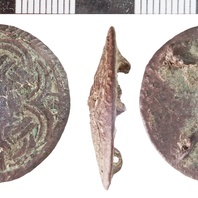
Viking Objects
Gilded Disc Brooch (NLM-783BCB)
This brooch is classed as Weetch Type 4 and resembles Viking-Age Terslev-style brooches. It is decorated with interlaced double strapwork and a cabled border and retains some traces of gilding. For more information on Scandinavian jewellery in England check out our blog: Brooches, Pendants and Pins: Scandinavian Dress Accessories in England.
Read More
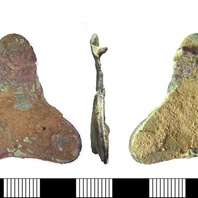
Item
Trefoil Brooch (LEIC-BD8163)
Trefoil brooches were characteristically Scandinavian women’s wear. However, many examples found in the East Midlands were probably made in the Danelaw, and may have been copies of Scandinavian styles, instead of being imported from Scandinavia. The decoration on this example features a foliate design. For more information on Scandinavian jewellery in England check out our blog: Brooches, Pendants and Pins: Scandinavian Dress Accessories in England.
Read More
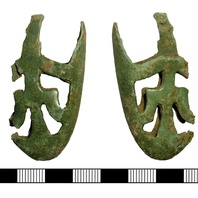
Viking Objects
Scabbard Chape (NLM-5BD697)
The incomplete openwork tongue-shaped front plate of this chape is decorated with at least six asymmetrical apertures and resembles similar chapes with ‘Birka Falcon’ decoration.
Read More
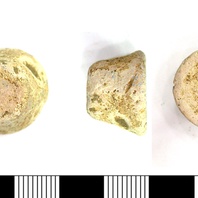
Viking Objects
Lead-Alloy Gaming Piece (LEIC-F39697)
This and similar pieces have also been interpreted as weights although the gaming-piece interpretation is more secure. Pieces like this would have been used to play hnefatafl and/or Nine Men’s Morris, both of which are known to have been played in Scandinavia in the Viking Age.
Read More
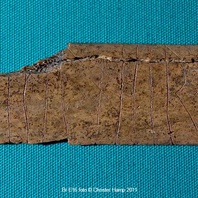
Viking Objects
Rune Inscribed Rib (LCNCC : 1999.103.104)
Runes were used not only for monumental inscriptions, or to mark ownership of valuable objects, but also in more informal contexts. In this case the animal bone suggests an after-dinner pastime after a good meal in the Anglo-Scandinavian trading centre of Lincoln. The runes read ——l × hitir × stin × … Only two words of the Old Norse inscription can be read with certainty, and even so they are ambiguous. One possible interpretation is ‘[someone] is heating a stone’ the other is ‘[someone] is called Stein’. The bone is fragmentary, but the inscription may never have been intended to make much sense. The object dates from around the 10th century. It is one of only three runic inscriptions from the East Midlands.
Read More
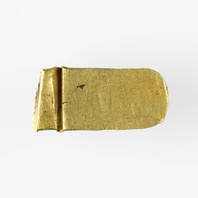
Viking Objects
Hack-gold (CM.1800-2008)
This rounded ingot terminal was cut from a larger rectangular ingot. Though rarer than hacksilver, this gold ingot formed part of the bullion currency used by Vikings in England and may be associated with their winter camp in Torksey.
